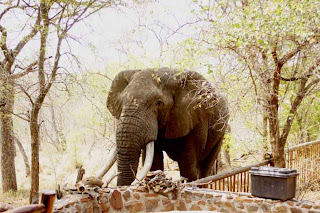The
plentiful rains of the past month or so have changed the appearance of the bush
completely. The vista down to the
waterhole and beyond to the rise is now green and lush with the occasional
flash of yellow from the African Weeping Wattle.
 |
| 'Baboon's tail' in flower |
Game tends
to be rather more sparse with all the water available in the surrounding bush,
but there are other treats to be found – the very beautiful but short lived
flower on the strange looking plant commonly known as ‘baboon’s tail’ is one
example. This stunning flower only
appears after rains and then transforms the rather ugly stumpy plant with its
lovely blooms.
 |
| Giant land snail |
The giant
land snail also makes an appearance after rains. Normally we see the empty shells lying around
in the bush, bleached white by the sun but recently they have been quite active
in the gardens (eating the grass), extraordinary to watch as the giant foot
ripples over the ground.
 One of our favourite sights at this time of the
year is the arrival of the young impalas.
We have spotted the first of these in the last week and had a good
sighting of them on the birdpool camera trap.
One of our favourite sights at this time of the
year is the arrival of the young impalas.
We have spotted the first of these in the last week and had a good
sighting of them on the birdpool camera trap.

 To complete
our news for this time, a wonderful cloud formation ‘snapped’ at sunset one
afternoon from the top of the game viewing tower.
To complete
our news for this time, a wonderful cloud formation ‘snapped’ at sunset one
afternoon from the top of the game viewing tower. 













































